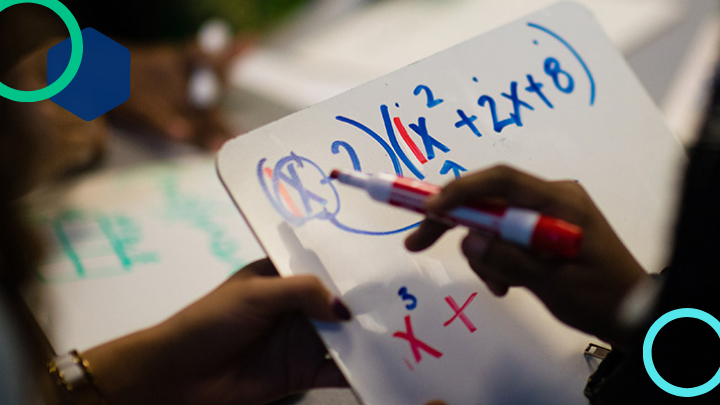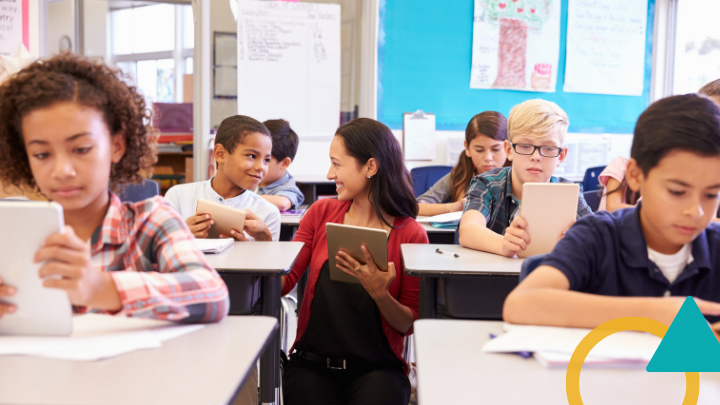The way students learn and interact with math has changed. Teachers are rapidly learning and adapting to new curriculums, new standards, and shifts in practice, while students are becoming empowered to take the lead in their learning and entering classrooms where the teacher is transitioning from the deliverer of knowledge to the facilitator of discovery.
At the forefront of this shift in the delivery of student-centered mathematical instruction is student discourse. When students are talking about math with their peers, they are able to connect their knowledge with other students’ ideas, build a contextual understanding of complex topics, and explore various approaches to solving problems. At the same time, the teacher is able to assess student comprehension and mastery, while listening for gaps in understanding and possible areas of growth. There is a strategic difference between “telling students to talk” and establishing a purpose and expectations for student discourse.
If you’re a teacher, you’ve probably heard of discussion strategies like Turn and Talk, Think-Pair-Share, or Elbow Partners. But are those strategies alone enough? Are your students having meaningful, productive, focused conversations about the Math they are interacting with? Are they comparing various problem-solving techniques, discussing steps they took to solve complex problems, and using discourse to fill in gaps in their understanding? If the answer is no, try combining several procedural supports with discussion strategies like Turn and Talk to help shift your students towards productive discourse in your Math classroom.
1. A Visible Timer
A visible timer helps instill a sense of urgency during partner or group talk. Giving students a set amount of time to discuss a problem with their partner helps students hold themselves and their peers accountable during the discussion. For example, if students are working with a partner, give each student two minutes to silently solve the problem, one minute each to discuss their approach and solution, and then two minutes to ask questions and revise their work based on the discussion. A timer can help students stay focused on the task at hand because they know they have a set amount of time to complete the discussion.
2. Accountable Talk Stems or Sentence Starters
Talk stems are sentence starters that structure and guide the expression of thinking. Accountable talk stems can help guide students towards specific, meaningful discussions. These stems can also help students learn how to respond to and question their peers in a meaningful way. Several sentence starts to try in your math classroom include:
- I understand …….. but the step I’m struggling with is ……… because ……
- Some of the words I don’t understand in this problem are …………..
- I’m confident about ……….. in this problem, but I’m still unsure about how to ……….
- My strategy is like/unlike yours because ……………..
- I think the first step I would take to solve this problem is ……….
When introducing sentence starters to students, display the stems students should use or provide students with a copy of the accountable talk stems to reference. Structure the student talk like you normally would, but tell students that they should start their statement or sentence with one of the sentence starters. This helps students immediately focus their conversations around the Math and the problem-solving approach they used, instead of just talking about the correct solution to the problem. The accountable talk stems pair well with the 2-4-6-8 Problem Solving strategy in the BetterLesson Lab.
3. Circulating to Sequence, Not to Answer Questions
For a teacher, choosing not to provide immediate support or help when students have a question is a difficult shift to make. During student discussion, though, the teacher should be circulating around the room to listen, not to answer questions to allow students time to grapple with a complex problem or task. When a teacher stops to work with a group on a specific question during partner or group talk, the rest of the room is more likely to get off task, increase in volume, or lose focus. Tell students up front that during their partner talk or group talk, you will not be answering any questions – that will come when the class comes back together. Instead of moving around the room to provide support, circulate the room with the intention of listening to responses, jotting down key ideas, misconceptions, and sequencing student responses that you would like to surface with the entire class when the students come back together. If students are struggling to drive their learning and regularly express that they want or need your help, consider trying the Ask Three Before Me strategy in the BetterLesson Lab (requires a BetterLesson account).
4. Share For Your Partner, Not For Yourself
It’s no surprise that students struggle with confidence in the math classroom. Teachers are regularly trying to find new ways to build student confidence around math. Students who feel like they are not “good” at math are less likely to have authentic, public conversations about math. For students who struggle with confidence, asking them to share their ideas with the class can be overwhelming and scary. Instead, have students talk with partners, with the expectation that they will share their partner’s ideas or problem-solving approach with the class. The Rally Coach strategy from BetterLesson helps students begin to work with their partner to coach one another through a problem or question. This helps lower the stakes for students because they do not feel the pressure of sharing their own ideas in front of the class.
5. Set Clear Procedural Expectations Up Front
Student discourse breaks down when students are not aware of the expectations and structure around the discussion strategy they are participating in. Merely telling students to “Think-Pair-Share” with their partner isn’t enough. When guidelines and expectations are not given, students will are more likely to be off-task or have off-topic conversations. One way to prepare students to engage in academic conversations is to provide them with clear expectations at the beginning of the discussion activity. Give students step-by-step instructions explaining how the discussion protocol will work. Use verbal or physical cues to bring students back together throughout the discussion. Explicitly explain what productive student talk looks and sounds like. If you want students moving in a specific way throughout the room or not moving at all, clearly explain those expectations. Make sure students know what the discussion protocol is and what steps they should take to be successful during partner talk. Check out the Creating and Improving Class Rules and Procedures with Students strategy in the BetterLesson lab for supports in setting classroom expectations with students.
Productive mathematical discourse is vital for students as they develop a deeper, contextual understanding of the content. With successful partner and group talk, students are able to assess and revise their approach to solving problems, are exposed to various problem-solving techniques and ways of thinking, and are able to make connections in the math classroom.







